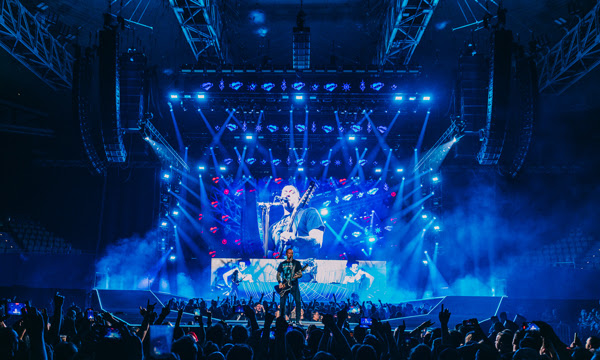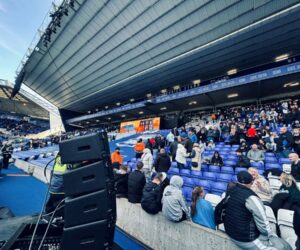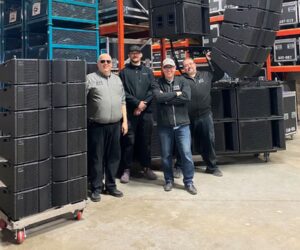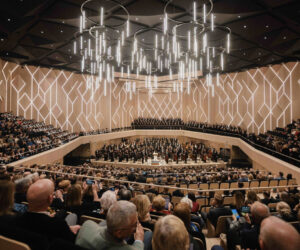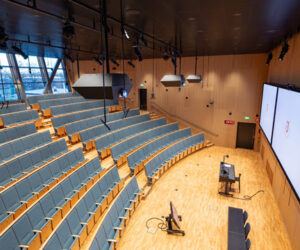The Servant of the Road World Tour of Europe/UK late last year by popular Danish band Volbeat was supported by a main system headed by Meyer Sound PANTHER large-format linear line array loudspeakers supplied by POOLgroup of Emsdetten, Germany.
Venues on the tour spanned a range of capacities, from halls and arenas to more 30,000 at a roofed football stadium in the Netherlands. “We have a directive straight from the band that every fan will have the full impact of the sound, regardless of where they are sitting,” says Dennie Miller, the band’s front of house mixer. “That’s not easy, particularly in light of the stringent maximum level restrictions in Europe, where they measure relative to the loudest point in the venue. That’s why we use delays in all but the smallest venues, because of the level loss due to distance.
“But fortunately, because PANTHER is self-powered and relatively lightweight, it is much easier to find optimum rigging points for the delays and scale the system as needed on a daily basis.”
After laying out the tour’s network infrastructure in Meyer Sound’s Nebra system management and monitoring software, creating a default snapshot encompassing the largest system configuration, Miller then worked with systems tech Samantha Boone to scale the system as needed for each venue.
“Having a smaller and lighter PA is no doubt a game-changer,” Miller continues. “Sure, it’s one thing to say we could carry the extra truck and bring in spreader trusses to handle the weight. But now, with PANTHER, we can approach management and show that we are making strides toward being more efficient and cost-effective.”
The maximum system configuration on the tour was deployed at the Netherlands’ GelreDome football stadium, where the main left and right hangs each flew 22 PANTHER loudspeakers, with 18 PANTHER loudspeakers flown in the two outfill arrays as well as in each of the four delay arrays. Primary low-frequency coverage was supplied by four hangs each with a dozen 1100-LFC low-frequency control elements, configured as left and right end-fire arrays.
Coverage for the tour’s “Parasite Pit,” a viewing section for 200 fans built inside of the stage, was handled by a single downward-aimed array of six PANTHER loudspeakers, augmented on the low end by 15 900-LFC compact low-frequency control elements on the floor. All loudspeakers were networked for monitoring on the Nebra platform, with audio transported between the 16 Galileo GALAXY 816 Network Platforms using the Milan AVB protocol.
“With such an incredible reduction in weight for the same power, we’re finding we can now fly the subwoofers where before we could not because of weight restrictions,” Miller says. “This is a huge stride forward. We’re getting more even coverage throughout the venue, the rigging crews are less stressed, and management is happy because we’re not spending money on spreader trusses. PANTHER is good for the band and good for the fans as well as for the bottom line. The sound is powerful, it’s visceral, and it’s in your face when you need that. What’s not to like?”
Miller also employed the Meyer Sound MAPP 3D prediction program: “It’s been an absolute godsend, particularly in dealing with acoustically problematic venues. A great example is Frankfurt’s Festhalle with its domed roof and curved balconies. We thought we had done a good job in the past, but when we looked again in MAPP 3D we saw we were missing the mark. We rigged it differently this time and it was a quantum leap forward. We essentially cut the RT time in half.”
In addition to Boone, team members included POOLgroup account manager Johannes Rosel, tour manager Guy Sykes, and monitor engineer Pat Rowe, with the latter riding herd on 20 Meyer Sound MJF‑210 stage monitors built into the staging deck. Miller mixed FOH using an Avid S6L while Rowe worked behind a Midas Pro X console. POOLgroup supplied the Meyer Sound house system and monitor loudspeakers, while the front-end FOH and monitor control packages came from UltraSound of Petaluma, CA.


